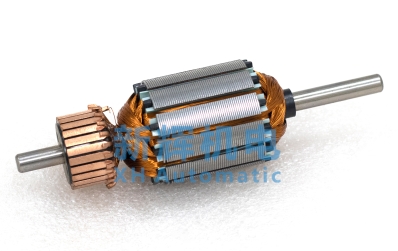What are the materials used for the laminations in the stator and rotor of a motor?
The rotor of a DC motor consists of electrical steel laminations. When the rotor rotates in the magnetic field of the motor, it generates a voltage in the coils, which creates eddy currents. Eddy currents are a type of magnetic loss, and eddy current losses lead to power losses. Several factors affect the effect of eddy currents on power loss, such as the electromagnetic field, the thickness of the magnetic material, and the density of the magnetic flux. The resistance of the material to the current affects how eddy currents are generated, for example, when the material is too thick, the cross-sectional area increases, leading to eddy current losses. Thinner materials need to be used to minimize the cross-sectional area. To make the material thinner, manufacturers use several thin sheets called stacked sheets to make up the armature core; unlike thicker sheets, thinner sheets produce higher resistance, which results in fewer eddy currents.
The choice of material used for motor laminations is one of the very important considerations in the motor design process, and due to their versatility, some of the often popular choices are cold rolled motor laminations and silicon steel. High silicon content (2-5.5 wt% silicon) and sheet (0.2-0.65 mm) steels are soft magnetic materials for motor stators and rotors, where the addition of silicon to the iron results in lower coercivity and higher electrical resistivity, and the reduction in sheet thickness results in lower eddy current losses.

Cold rolled laminated steel is one of the very low cost materials in mass production and is one of the very popular alloys. The material is easy to stamp and produces less wear on stamping tools than other materials. Motor manufacturers anneal motor laminated steel with an oxide film that increases the interlayer resistance, making it comparable to low-silicon steels. The difference between motor laminated steel and cold rolled steel sheet is in the composition of the steel and processing improvements such as annealing.
Silicon steel, also known as electrical steel, is a mild steel to which a small amount of silicon has been added to reduce eddy current losses in the core. Silicon protects the core of stators and transformers and reduces the hysteresis of the material, which is the time between the initial generation of a magnetic field and its complete generation. Once cold rolled and properly oriented, the material can be used in lamination applications. Typically, silicon steel laminations are insulated on both sides and stacked on top of each other to minimize eddy currents, and the addition of silicon to the alloy has a significant impact on the life of stamping tools and dies.
Silicon steel is available in a variety of thicknesses and grades, with the best types depending on the allowable iron loss in watts per kilogram. Each grade and thickness affects the surface insulation of the alloy, the life of the stamping tool, and the life of the die. Like cold rolled motor stack steel, annealing helps to strengthen the silicon steel, and the post-stamping annealing process clears away excess carbon, thereby reducing stress. Depending on the type of silicon steel used, additional treatment of the component is required to further relieve stress.
The cold rolled steel manufacturing process adds significant advantages to the raw material. Cold rolled manufacturing is manufactured at or slightly above room temperature, resulting in the steel grain remaining elongated in the direction of rolling. The high pressures applied to the material during the manufacturing process give the cold steel its inherent rigidity requirements, resulting in smooth surfaces and more accurate consistent dimensions. The cold rolling process also induces what is known as “strain hardening”, which can increase the height of hardness by as much as 20% compared to unrolled steel, in hardness grades known as full hard, semi-hard, quarter-hard, and surface rolled. Rolling is available in a variety of shapes, including round, square and flat, with grades available to suit a wide range of strength, toughness and ductility requirements, and its low cost continues to be the backbone of all stack manufacturing.
Conclusion
The rotor and stator in an electric motor are made from hundreds of thin electrical steel sheets laminated and joined together to minimize eddy current losses and increase efficiency, both with insulating coatings on both sides, which laminate the steel and cut off the eddy currents between the layers in motor applications. Typically, electrical steel is riveted or welded to ensure the mechanical strength of the laminations. Damage to the insulating coating from the welding process can lead to degradation of magnetic properties, changes in microstructure, introduction of residual stresses, etc. Striking a compromise between mechanical strength and magnetic properties is a huge challenge.









